Step Length After Tibial Plateaur Fracture Systematic Review
Abstract
Fracture gap and step-off measurements on 2DCT-slices probably underestimate the circuitous multi-directional features of tibial plateau fractures. Our aim was to develop a quantitative 3D-CT (Q3DCT) fracture analysis of these injuries. CT-based 3D models were created for 10 patients with a tibial plateau fracture. Several 3D measures (gap area, articular surface involvement, 3D displacement) were adult and tested. Gaps and stride-offs were measured in 2d and 3D. All measurements were repeated by vi observers and the reproducibility was determined by intra-class correlation coefficients. Q3DCT measurements demonstrated a median gap of five.iii mm, step-off of 5.2 mm, gap expanse of 235 mmtwo, articular surface involvement of 33% and 3D displacement of six.ane mm. The inter-rater reliability was higher in the Q3DCT than in the 2DCT measurements for both the gap (0.96 vs. 0.81) and footstep-off (0.63 vs. 0.32). Q3DCT measurements showed excellent reliability (ICC of 0.94 for gap area, 1 for articular surface involvement and 0.99 for 3D displacement). Q3DCT fracture assay of tibial plateau fractures is viable and shows excellent reliability. 3D measurements could exist used together with the electric current classification systems to quantify the true extent of these complex multi-directional fractures in a standardized way.
Introduction
Tibial plateau fractures correspond 1–2% of all fractures in adults and are reported as one of the most challenging injuries of the knee1. Since the tibial plateau is among the virtually loadbearing areas in the body, any fractures affect knee alignment, stability and move. Acceptable handling is crucial to minimize patient disability and other consequences (e.g., posttraumatic arthritis)2. Acceptable nomenclature and fracture assessment of tibial plateau injuries is essential in the option of the correct treatment strategythree. Currently, the Schatzker and AO/OTA are the about widely used and accepted classification systems4,v,6. Although these classifications represent the gross fracture patterns, they practice not include detailed information most the severity of the dislocation, gap, and step-off7,8. Furthermore, it has been reported that these classification systems have their limitations, because of their moderate inter-rater reliability3,ix,10.
The goal of whatsoever surgical treatment of the fractured tibial plateau is to restore the articular surface and provide a stable fixation, which allows immediate postoperative exercising11. A CT-browse provides data about the fracture anatomy, which helps in the doc's option between bourgeois or operative treatment. In clinical practice, the surgeon scrolls through the CT slices and tries to get a general impression of the fracture. Furthermore, the gaps and step-offs on the various slices tin be measured. The physician's assessment of the CT-scan, yet, depends heavily on the manner these are performed and which CT slice is selected for the measurements. Therefore, two-dimensional (2nd) measurements of the CT browse can vary significantly between physicians. Moreover, it is difficult to quantify the true extent of the injuries from a few 2D CT slices, since articular incongruity frequently involves three-dimensional (3D) displacement (east.g, gaps and step-offs) in multiple planes12.
The importance of the three-dimensional aspect of tibial plateau fractures was recently acknowledged with the attempt to convert the most commonly used Schatzker nomenclature to a new 3D classification system by the original author who posed this classification four decades ago13. In other complex fractures types has been demonstrated that the implementation of 3D engineering for visualization, classification and surgical planning provides clinical benefits. The application of 3D technology in acetabular fracture surgery for instance improved didactics, nomenclature, surgical planning and recently resulted in the development of patient-specific implants at our sectionfourteen,15,16. Likewise, in the field of oral and maxillofacial surgery the use of 3D virtual planning and guided surgery is of substantial clinical value in order to perform complex jaw reconstructions within millimeters17. Recently, 3D statistical shape models of the tibia were introduced in this journaleighteen. These models seem to be a promising tool for assessing anatomical variations and will exist helpful in gaining a more patient-specific arroyo regarding fracture reduction techniques and implant fitting. In line with these developments, we present a quantitative 3D CT (Q3DCT) measurement tool for tibial plateau fractures. To our best knowledge, 3D measurement tools for these types of fractures are all the same lacking.
Quantitative 3DCT measurements have the potential reward of representing the multidirectional (3D) attribute of fractures and they provide a compatible way of measuring the gap and footstep-off in these injuries12,19,20,21,22,23. The clinical applicability of these 3DCT measurements would be usage in improver to the current classification systems to assess initial and/or residual deportation, and they might eventually be related to patients reported outcome measures. The goal of this written report was to develop a standardized 3D measurement tool to make up one's mind quantitatively the extent of the tibial plateau fractures.
Methods
Patients
Ten patients with a tibial plateau fracture were included in this written report. All of them underwent surgery at the University Medical Center of Groningen (UMCG). They were included upon the availability of a pre-operative CT-scan of the injured knee joint with a slice thickness of 0.half-dozen mm (pixel spacing: 0.44 × 0.44 mm). The CT data were used to develop a quantitative 3D measurement technique for tibial plateau fractures. All the fractures were graded according to the Schatzker and AO/OTA nomenclature systems past using both preoperative plain radiographs and CT-scans. The institutional review lath of the Academy Medical Center Groningen approved the study procedures and the enquiry was performed in accord with the relevant guidelines and regulations. Informed consent was obtained from all subjects.
3D Fracture models
Mimics Medical software package (Version 19.0, Materialise, Leuven, Belgium) was used to create 3D models of all the injured knees. First, the CT data (DICOM files, Digital Imaging and Communications in Medicine) were imported. Secondly, a segmentation process was performed by using a preset os threshold (Hounsfield Units ≥226) combined with region growing in order to split the independent fragments. Subsequently the fragments were checked and if needed manually separated from next fragments. Smoothing was applied (factor 0.4) and each fragment was assigned a dissimilar color. Subsequently, virtual anatomical reduction of the fragments was performed. The fragment was moved to its anatomical position and exactly fitted on a template of a good for you tibia. The accurateness of the reduction was checked and approved past 2 surgeons. Effigy one represents the 3D models of ix of the 10 included patients (the 3D model of patient 7 is presented in Figs 2–four).
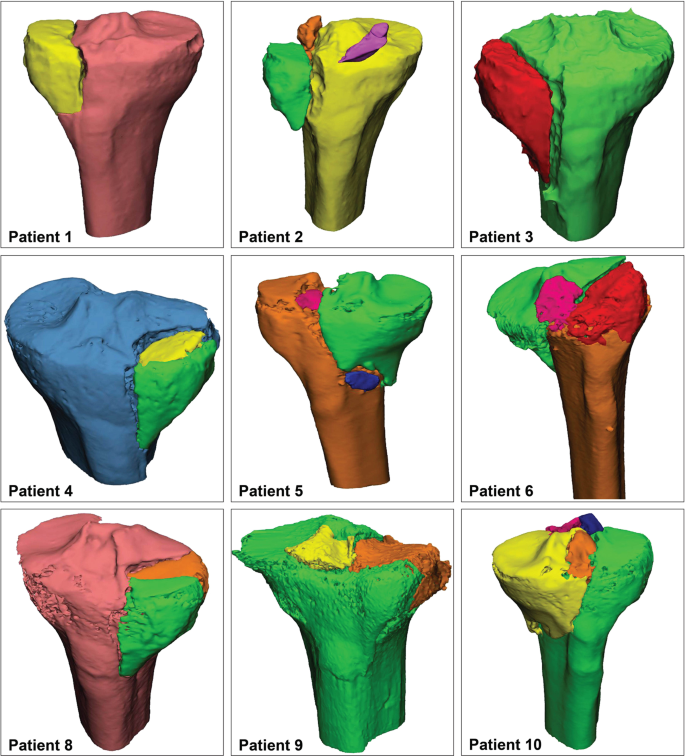
3D reconstructions of all the patients except for patient 7. This patient is used to illustrate the Q3DCT measurements in Figs 2–4.
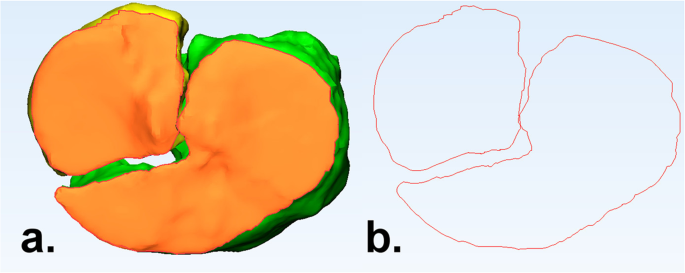
(a) The articular surface, in terms of the top axial view of the tibial plateau, is marked orange; (b) The contour of the articular surface, demonstrating the fracture design.
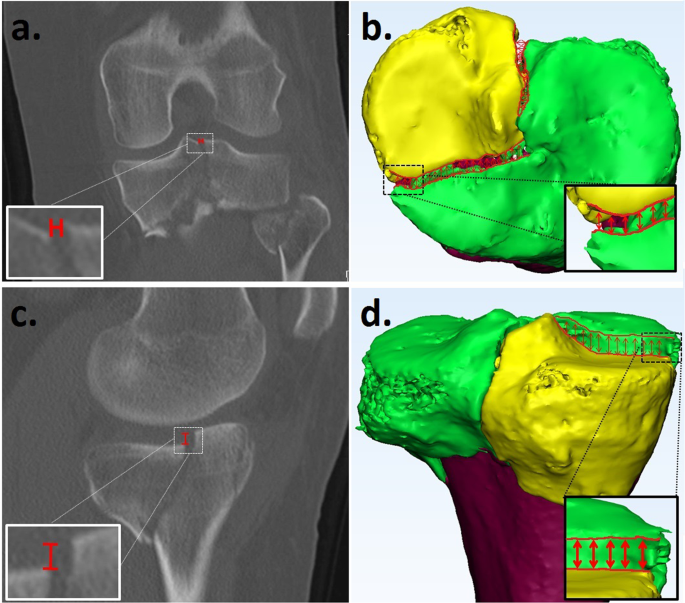
Gap measurement from a 2DCT slice (a) and a Q3DCT model (b). Pace-off measurement on 2D (c) and Q3DCT. (d) The 2DCT slices had to exist scrolled to find the maximum gap and pace-off. The Q3DCT has the advantage that the gap and step-off could be measured between all points along the fracture lines inside the aforementioned plane providing a maximum and a mean 3D value of both parameters.
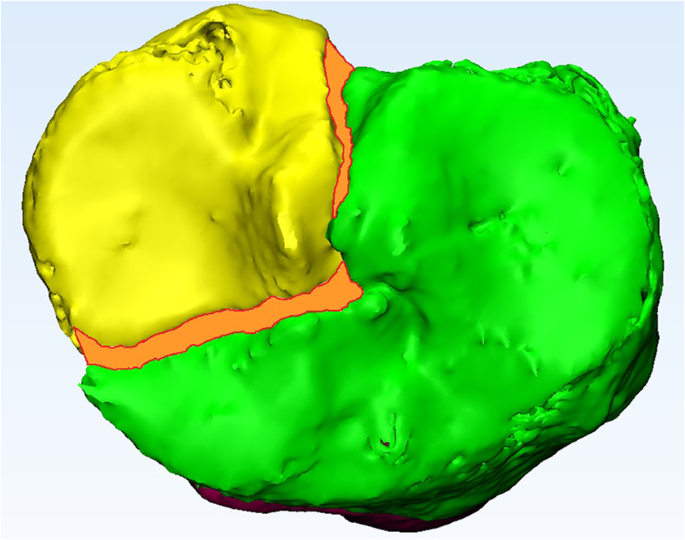
Measurement of the gap area (mm2), which is marked as the orange surface area between the fracture lines.
Quantitative 3D measurements
The 3D measurements were conducted by using both the iii-matic Medical (Version xi.0, Materialise, Leuven, Belgium) and Matlab (R2014B, Mathworks, Natick, Massachussetts, U.s.a.) software. Commencement of all, the edges of all the fracture fragments at the level of the articular surface were determined past using the iii-matic (Fig. ii). The "classic" gaps and step-offs were measured in Q3DCT. Furthermore, three additional 3D parameters were introduced, namely the gap area, articular surface involvement and 3D-deportation. The details of these measurements are antiseptic below.
Gap and step-off
The 3D articular gaps and footstep-offs were determined by calculating the differences in distance and height between the fracture lines of adjacent fracture fragments at the articular level (Fig. 3). In order to calculate the gap and step-off, the fracture lines were identified and exported from the 3-matic to the Matlab software. A gap was defined equally a separation of fracture fragments along the articular surface. A step-off was characterized as a separation of fracture fragments perpendicular to the articular surface. Besides the maximum gap and step-off, the hateful of the gaps and step-offs were determined between all the points along adjacent fracture lines in the 3D model.
Furthermore, the maximum gap and step-off in the coronal, sagittal and axial plane of the 2DCT slices were measured according to current do in club to compare them with the 3DCT measurements. The gaps and pace-offs were measured in the CT slices and the largest gap and pace-off was used for the assay (Fig. 3a,c).
Gap expanse
The gap area is defined as the total surface area of the gap betwixt all fracture fragments. It was measured by calculating the surface area (mmii) between all the fragment fracture lines, which were projected in ane aeroplane at the articular level (Fig. iv).
Articular Surface interest
Articular surface involvement represents to what extent the articular surface is damaged due to the fracture. It was determined by dividing the sum of all the articular surface areas of the displaced fracture fragments by the total joint surface of the tibial plateau according to formula ane.
$$Articular\,surface\,interest=\frac{\sum Fragmen{t}_{i}}{Full\,surface}\times 100 \% $$
(1)
3D displacement
The extent of dislocation of each fragment was determined by calculating its 3D displacement forth the axis in three directions (ten, y and z). In order to calculate the 3D deportation, the fracture has to be reduced in the 3D model. The 3D model of the fragment represents numerous surface points (vertices). The 3D displacement (in mm) was determined past the sum of the distances between every point before and after reduction co-ordinate to formula 2. A 3D displacement is therefore determined for each fragment based on tens of thousands of single points. Furthermore the displacement of each part of the fragment can be presented every bit a altitude map equally shown in Fig. 5.
$$3D\,Displacement=\sum \sqrt{\Delta {x}_{i}^{2}+\Delta {y}_{i}^{ii}+\Delta {z}_{i}^{2}}$$
(2)
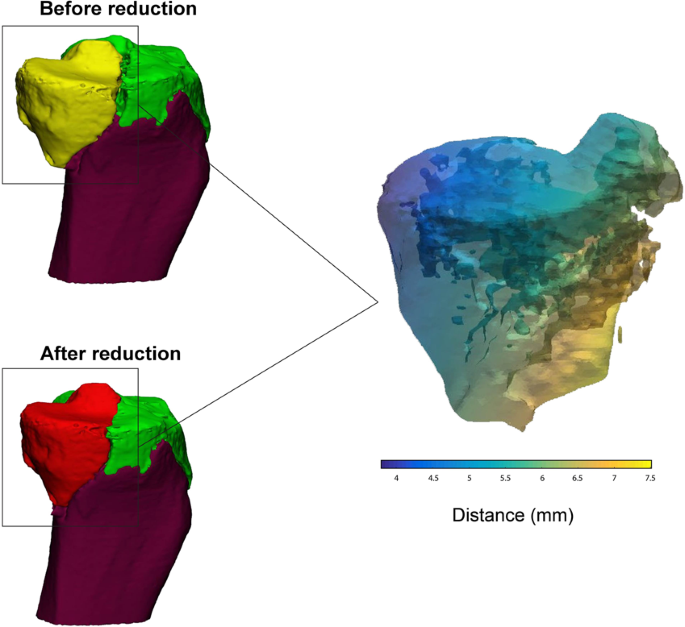
Measurement of the 3D displacement (mm). Left: fragment of the tibial plateau fracture earlier (xanthous) and after (reddish) reduction. Right: distance map representing the difference in the fragment'due south position before and after the reduction (3D displacement). The colour corresponds with the severety of the displacement, whereby yellow represents a relatively big displacement and blue represents a relatively modest displacement.
Statistical analysis
Statistical assay was performed with SPSS (version 23, IBM, Chicago, IL, United states of america). The Wilcoxon signed-rank test was used to evaluate differences between 2DCT and 3DCT measurements of the gaps and footstep-offs. A P-value of less than 0.05 was considered statistically significant. Furthermore, a Spearman'southward rank-lodge correlation coefficient was used to assess whether there was a correlation between the maximum gap (measured in 2D and Q3DCT) and the gap area.
Reliability
To assess the reliability of the 3D measurements, six observers independently performed the Q3DCT measurement on all the cases. Furthermore, vi observers measured the gap and step-off on 2DCT slices from all the cases. The Cohen's Kappa was calculated to determine the agreement between the observers regarding piece pick and the maximum gap and step-off measurement from the 2DCT images.
The inter-rater reliability (IRR) was calculated by using intraclass correlation coefficients (ICC). We used 2-way mixed, single measurements and accented agreement. Estimation of the ICC values was performed according to the guidelines proposed by Cicchetti24 whereby IRR is considered to be poor when the ICC values are less than 0.40, off-white when the values are betwixt 0.40 and 0.59, expert when the values are between 0.60 and 0.74 and excellent when the values are higher than 0.74.
In order to determine the reproducibility of the 3D-deportation, this measurement was repeated by one observer afterwards a period of 4 weeks. The IRR was determined from the 3D-displacement calculated on the two separate occasions.
Ethical approval
This study has been approved by the local medical ethical commission.
Results
X patients (half dozen females, 4 males, mean age 43 (range 18–81)) with a tibial plateau fracture were included and 3D computer models of their fractures were created (Fig. 1). V of them were treated with open reduction and plate fixation and v with percutaneous screw fixation only. The post-obit fracture types were included; one patient with a Schatzker 1, five with a Schatzker 2, three with a Schatzker 4 and one with a Schatzker 5 fracture. According to the AO/OTA classification arrangement, these injuries were classified as one 41-B1, eight 41-B3 and one 41-C1 fracture. The results of the second and Q3DCT measurements of the unlike types of fractures are presented in Table ane.
Quantitative measurements
The maximum gaps and step-offs, every bit measured on the Q3DCTs, are presented in columns four and 6 of Table 1, respectively. Inside the 10 patients, the measured maximum gaps showed a median value of v.3 mm (IQR: 4.four), whereas the maximum step-offs had a median value of 5.two mm (IQR: 2.3). The maximum gap and stride-off measurements from the 2D CT slices resulted in higher median values of 8.6 mm (IQR: 7.8) and 5.3 mm (IQR: ane.seven), respectively. No pregnant differences were plant betwixt both the maximum gap (P-value: 0.29) and step-off (P-value: 0.29) measured on the Q3DCTs and 2DCTs. The mean gaps and step-offs between all the points along the fracture lines were calculated for each case (Table 1; Columns five and 7) and showed values between 1–14 mm and i.vi–four.8 mm, respectively.
The gap area (cavalcade 8 of Table 1) was measured for each patient and demonstrated a median gap area of 235 mm2 (IQR: 233). The Spearman'south correlation coefficient between the maximum gap measured in second and the gap area was 0.94 (P < 0.001). The Spearman's correlation coefficient betwixt the maximum gap measured in Q3DCT and the gap expanse was 0.88 (P < 0.001). Notwithstanding, the maximum gap in some of the patients (cases 6, 7 and x) was relatively small but the gap area was quite large due to a multitude of fracture lines with moderate gapping.
The articular surface involvement (cavalcade nine of Table ane) could be determined for each patient and demonstrated a median value of 33% (IQR: 50). The three cases classified as Schatzker 4 (cases 5, 6 and 10) had the largest articular surface interest with values of over 75%.
The 3D deportation (columns x, 11 and 12 of Table 1) of each fracture fragment could as well be determined for all the cases. The number of fragments in each injury and the degree of their displacement was established in the 3D models. These measurements showed the feasibility of determining the 3D displacement of individual fracture fragments. The hateful 3D displacement of all the fragments in the various injuries was 6.i mm (IQR: 7.i).
Reliability
The inter-rater reliability (IRR) of the measured maximum gaps was establish to exist excellent with an ICC of 0.81 from 2DCTs. The reliability of the maximum gap measurements increased to 0.96 with Q3DCT (Table 2). The IRR of the pace-offs was found to be poor from 2DCTs, with an ICC of 0.32 and good from Q3DCTs, with an ICC of 0.63. On measuring the mean gaps and step-offs in the 3D fracture model, the IRR improved considerably to 0.97 and 0.fourscore, respectively. When measuring the maximum gaps and step-offs from the CT scans, the observers had selected unlike 2D slices. This led to a mean Cohen'due south kappa of 0.12 and 0.09 for the slice selection agreements betwixt the 2DCT gap and step-off measurements, respectively.
Figures 6 and 7 depict the degree of dispersion between observers when performing the 2DCT and Q3DCT measurements of the maximum gap and step-off for each patient. There was more than dispersion in the 2DCT measurements of the gap in vi out of the ten patients compared to the Q3DCT measurements. Regarding, the measurements of the step-off, the dispersion between 2DCT and Q3DCT was as distributed.
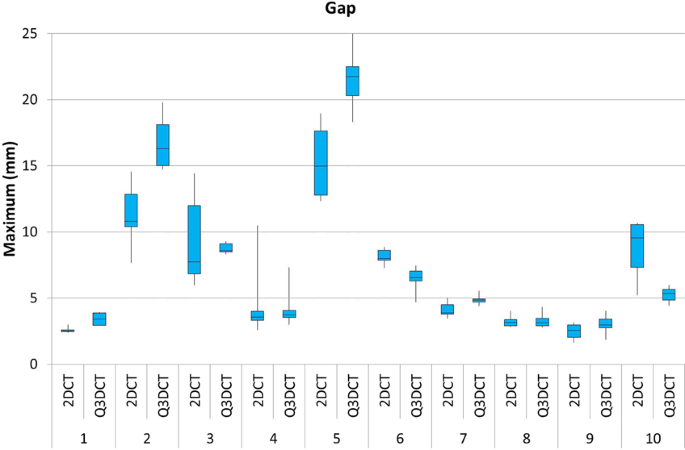
A boxplot showing the dispersion of the maximum gap measurements from 2DCT slices in comparison to our 3DCT measurements, performed by six different observers for all the patients.
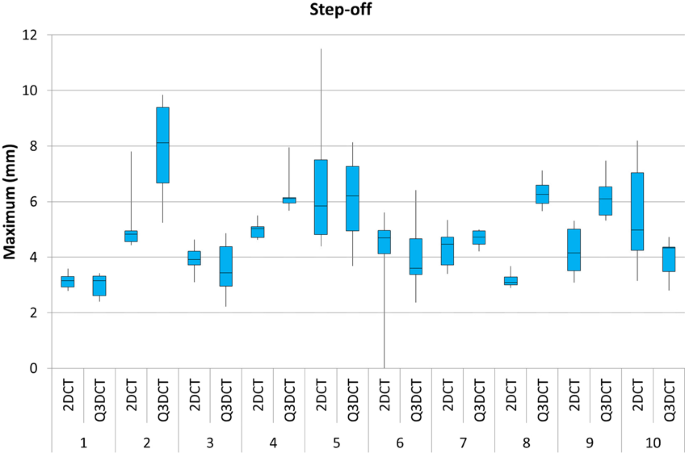
A boxplot showing the dispersion of the maximum pace-off measurements from 2DCT slices compared to to our Q3DCT method, performed past six different observers for all patients.
There was excellent reliability between the different observers for the additionally introduced Q3DCT measurements. The gap area showed an ICC of 0.94 (95% CI: 0.85–0.98), the articular surface involvement had an ICC of 1 (95% CI: 0.99–1), and the 3D-deportation demonstrated an ICC of 0.99 (95% CI: 0.96–ane).
Discussion
This report presents a quantitative 3DCT measurement technique to determine the 3D fracture characteristics of tibial plateau fractures. This study demonstrates that authentic intra-articular gap and step-off measurements in 3D are feasible for tibial plateau fractures. Furthermore, 3 boosted 3D measurement tools are presented, namely the gap surface area, articular surface involvement and 3D-displacement of individual fracture fragments, to gain a better 3 dimensional insight of the fracture.
Recently, Millar et al. extensively reviewed current classifications for tibial plateau fractures and they identified no less than 38 classification systemsthree. Moreover, most of these classification systems had moderate intra- and inter-observer reliability and did non provide quantitative information about the fracture patterns and morphology. They suggested the use of more sophisticated imaging modalities such as 3D CT to improve reliability estimates.
Q3DCT measurements have some potential advantages in comparison to 2DCT measurements. Starting time of all, the inter-rater reliability of 3D measurements is higher than 2DCT measurements in the current assay. The results of the 2DCT measurements depend heavily on the slice selection and the fashion gaps and footstep-offs are interpreted from unlike angles (axial, coronal or sagittal). The poor inter-observer agreement regarding the selected slice for the 2D measurement was illustrative for the complexity of performing compatible measurements in 2D. Especially patients, who sustained comminuted fractures (≥three fragments), demonstrated a high dispersion of maximum gap and pace-off measurements (Figs 6 and 7; patients ii, 5 and 10). Observers not just measured the gap and step-off at different 2DCT-slices, but besides betwixt different fragments. Q3DCT showed a lower dispersion in these patients in comparing with 2DCT. Except for patient 2, who had a small, severely displaced fragment (Fig. one; regal fragment) that was disregarded by the observers in the 2nd, only non in the 3D measurements. In contrast to 2D measurements, 3D analysis enables a complete and wider cess of the fracture. Likewise, Q3DCT has the potential to provide improved quantitative information nigh the extent of the fracture.
The showtime parameter, the gap area (Fig. 4), is a reliable tool to quantify the total gap area of the fracture. In daily exercise, the maximum fracture gap (mm) is more often than not determined from a single CT piece in the coronal, sagittal, or axial direction. This 2DCT measurement is neither standardized, nor suitable for measuring multiple gaps, and therefore does non represent the entire injury. A discrepancy in the 3D gap area and 2DCT maximum gap due to multiple gaps in different directions is, for instance, demonstrated in patients seven and 10 (Table 1, Fig. three). The potential advantages of gap measurements from 3D are that they correspond the gap of the entire fracture and tin be used every bit a standardized quantitative measure of the extent of the fracture.
The 2nd parameter, the articular surface interest, was plant to be a reliable parameter to appraise how much of the articular surface was afflicted by the fracture. It is no surprise that as the Schatzker classification increased, the per centum of articular surface involvement gradually increased equally well. However, substantial differences in articular surface involvement could be observed between patients who had like fracture types. For case, the articular surface involvement in all the cases with a Schatzker 2 injury varied from 12.7 to 39.7%. Therefore, this parameter could be a valuable addition to the currently used classification systems and might exist of interest in fracture analysis within different subsets of fracture patterns.
The 3rd parameter, 3D deportation, quantifies the displacement of each fracture fragment in all directions. The rationale behind exploring this parameter was that gaps and stride-offs might arise from the displacement of these fragments. In this written report, we demonstrated that it is possible to visualize the move, tilting and rotation of each fracture fragment in three-dimensional space. For case, this parameter might be of involvement for enquiry purposes regarding 3D assay of specific parts of the fracture. The value of the total 3D displacement of all fracture fragments together, as a quantitative measure of the severity of the fracture, needs further exploration.
The Q3DCT method also has certain limitations. One of these is that the edges of the articular surface and the fracture lines nonetheless demand to exist determined manually in the current software plan. An automatic edge detection tool for identifying the dissimilar fracture lines would be helpful to brand these 3D measurements more consequent. A software package with automatic detection tools, snap to fit reduction tools and incorporated 3D measurements is probably the next step to avoid inter-observer variability in 3D fracture assay. Of note is that the current workflow simply utilizes a CT-scan of the afflicted knee joint. However, if a 3D model of the non-afflicted genu had been available as well, this could have been used every bit a reference when analyzing the injured side. Finally, the electric current process of creating the 3D model and performing the measurements takes at to the lowest degree half an 60 minutes, depending on the complication of the fracture. However, further automation is being conducted for universal clinical applicability.
Q3DCT measurements of the fractured tibial plateau could exist considered an additional tool for the surgeon to assess and quantify preoperatively the extent of the fracture. The aim of this study was to present a standardized 3D measurement technique for tibial plateau fractures, which could be beneficial for further applications. These 3D measurements might also be helpful in comparison pre- and postoperative CT scans (if specifically requested) in order to assess the quality of the postoperative reduction. Finally, we included a case example where nosotros applied our 3D measurements to pre- and postoperative CTs of a patient who was operated on a tibial plateau fracture in order to demonstrate that these can be used as a standardized quantitative measure for assessing the quality of the postoperative reduction (Fig. 8). Furthermore, the connection between quantitative 3D measurements and patient reported outcomes might be of involvement to surgeons to reassess fracture parameters and and then decide whether to proceed to an operative treatment regimen.

These images represent a clinical case in which we demonstrate the application of the quantitative 3D fracture measurements. Pre- and postoperative 3D assessment of a patient who was operated on a Schatzker 3 tibial plateau fracture. A 3D model of the pre-operative CT scan displayed a mean 3D gap of 0.5 mm, a pace-off of 3.3 mm, a gap surface area of 27 mm2 with an articular surface involvement of 32.5% consisting of 3 fracture fragments. An open up reduction and plate osteosynthesis was performed. A 3D model of the postoperative CT scan demonstrated an anatomical reduction of the fracture with a twenty% decrease in the mean 3D gap (0.5 mm pre vs 0.4 mm postoperative), an 85% decrease in the mean 3D step-off (3.3 mm pre vs 0.v mm postoperative), and a 10% subtract in the gap area (27 mm2 pre vs 24 mm2 postoperative).
Conclusion
We present a feasible and reliable method for Q3DCT fracture analysis of tibial plateau fractures. These 3D measurements can, potentially, be used to assess complex multi-directional injuries and to quantify the extent of the fracture.
Data Availability
The authors declare that the data supporting the findings of this study are bachelor inside the paper.
References
-
Court-Brown, C. Yard. & Caesar, B. Epidemiology of developed fractures: A review. Injury. 37, 691–697 (2006).
-
Agnew, Southward. G. Tibial plateau fractures. Oper. Tech. Orthop. 9, 197–205 (1999).
-
Millar, Southward. C., Arnold, J. B., Thewlis, D., Fraysse, F. & Solomon, L. B. A systematic literature review of tibial plateau fractures: What classifications are used and how reliable and useful are they? Injury. 49, 473–490 (2018).
-
Müller, Yard. East. Müller AO Nomenclature of Fractures—Long Bones. AO Foundation (1987).
-
Schatzker, J., McBroom, R. & Bruce, D. The tibial plateau fracture. The Toronto experience 1968–1975. Clin. Orthop. Relat. Res. 94–104 (1979).
-
Jeelani, A. & Arastu, M. H. Tibial plateau fractures - review of current concepts in direction. Orthop. Trauma 31, 102–115 (2017).
-
Mellema, J. J. et al. Tibial Plateau Fracture Characteristics: Reliability and Diagnostic Accuracy. J. Orthop. Trauma. 30, e144–51 (2016).
-
Molenaars, R. J., Mellema, J. J., Doornberg, J. N. & Kloen, P. Tibial Plateau Fracture Characteristics: Computed Tomography Mapping of Lateral, Medial, and Bicondylar Fractures. J. Bone Articulation Surg. Am. 97, 1512–20 (2015).
-
Maripuri, Due south. Northward., Rao, P., Manoj-Thomas, A. & Mohanty, 1000. The classification systems for tibial plateau fractures: How reliable are they? Injury 39, 1216–1221 (2008).
-
Charalambous, C. P. et al. Inter- and intra-observer variation of the Schatzker and AO/OTA classifications of tibial plateau fractures and a proposal of a new classification organization. Ann. R. Coll. Surg. Engl. 89, 400–404 (2007).
-
Prat-Fabregat, S. & Camacho-Carrasco, P. Treatment strategy for tibial plateau fractures: an update. EFORT open reviews. 1(5), 225–232 (2016).
-
De Muinck Keizer, R. O. et al. Articular gap and step-off revisited: 3D quantification of operative reduction for posterior malleolar fragments. Journal of Orthopaedic Trauma. xxx, 670–675 (2016).
-
Kfuri, Chiliad. & Schatzker, J. Revisiting the Schatzker classification of tibial plateau fractures. Injury. 49(12), 2252–2263 (2018).
-
Huang, Z. et al. Three-dimensional printing model improves morphological understanding in acetabular fracture learning: A multicenter, randomized, controlled study. PloS one. thirteen(one), e0191328 (2018).
-
Fang, C. et al. Surgical applications of three-dimensional printing in the pelvis and acetabulum: from models and tools to implants. Der Unfallchirurg. 1–8 (2019).
-
Merema, B. J. et al. The blueprint, product and clinical application of 3D patient-specific implants with drilling guides for acetabular surgery. Injury. 48(11), 2540–2547 (2017).
-
Schepers, R. H. et al. Accuracy of secondary maxillofacial reconstruction with prefabricated fibula grafts using 3D planning and guided reconstruction. Journal of Cranio-Maxillofacial Surgery. 44(iv), 392–399 (2016).
-
Quintens, 50. et al. Anatomical Variation of the tibia-a master Component Assay. Scientific reports. ix(one), 7649 (2019).
-
Mellema, J. J., Janssen, S. J., Guitton, T. Yard. & Ring, D. Quantitative three-dimensional computed tomography measurements of coronoid fractures. J. Mitt Surg. Am. 40, 526–533 (2015).
-
Guitton, T. 1000., van der Werf, H. J. & Band, D. Quantitative iii-dimensional computed tomography measurement of radial caput fractures. J. Shoulder Elbow Surg. 19, 973–vii (2010).
-
Guitton, T. G., Van Der Werf, H. J. & Ring, D. Quantitative measurements of the coronoid in healthy adult patients. J. Hand Surg. Am. 36, 232–237 (2011).
-
Guitton, T. Thou., van der Werf, H. J. & Ring, D. Quantitative measurements of the volume and surface area of the radial head. J. Paw Surg. Am. 35, 457–463 (2010).
-
Brouwer, K. M., Bolmers, A. & Ring, D. Quantitative 3-dimensional computed tomography measurement of distal humerus fractures. J. Shoulder Elb. Surg. 21, 977–982 (2012).
-
Cicchetti, D. Five. Guidelines, criteria, and rules of thumb for evaluating normed and standardized assessment instruments in psychology. Psychol. Assess. vi, 284–290 (1994).
Writer information
Affiliations
Contributions
This study represents a great deal of try, resources and dedication of the authors in the inclusion og tibial plateau fracture cases, reviewing and reconstructing all cases and performing measurement analysis. All the authors have contributed materially to the elements below: Study design: Northward.A., J.K., C.S., Thou.t.D., J.P.d.Five., A.G., P.five.O., K.W. and F.I.J. Gathered data: N.A., J.K., A.M., P.v.O. and F.I.J. Analysed data: N.A., J.K., M.Westward. and F.I.J. Initial draft: N.A., J.Grand., C.S., Thousand.t.D., J.P.d.5., A.K., P.five.O., K.W. and F.I.J. Ensured accurateness of data: Due north.A., J.1000., C.S., Yard.t.D., J.P.d.V., A.M., P.v.O., One thousand.Westward. and F.I.J.
Corresponding author
Ideals declarations
Competing Interests
The authors declare no competing interests.
Boosted information
Publisher'south note Springer Nature remains neutral with regard to jurisdictional claims in published maps and institutional affiliations.
Rights and permissions
Open Access This article is licensed under a Artistic Commons Attribution 4.0 International License, which permits use, sharing, adaptation, distribution and reproduction in any medium or format, equally long equally you give appropriate credit to the original author(s) and the source, provide a link to the Creative Eatables license, and indicate if changes were made. The images or other third party textile in this commodity are included in the commodity'southward Creative Commons license, unless indicated otherwise in a credit line to the fabric. If cloth is not included in the article's Creative Commons license and your intended use is not permitted by statutory regulation or exceeds the permitted use, you will need to obtain permission directly from the copyright holder. To view a re-create of this license, visit http://creativecommons.org/licenses/by/4.0/.
Reprints and Permissions
About this article
Cite this article
Assink, N., Kraeima, J., Slump, C.H. et al. Quantitative 3D measurements of tibial plateau fractures. Sci Rep 9, 14395 (2019). https://doi.org/10.1038/s41598-019-50887-six
-
Received:
-
Accepted:
-
Published:
-
DOI : https://doi.org/ten.1038/s41598-019-50887-6
Further reading
Comments
By submitting a comment y'all agree to abide past our Terms and Community Guidelines. If you discover something calumniating or that does non comply with our terms or guidelines please flag it as inappropriate.
wilkersonnour1977.blogspot.com
Source: https://www.nature.com/articles/s41598-019-50887-6
0 Response to "Step Length After Tibial Plateaur Fracture Systematic Review"
Post a Comment